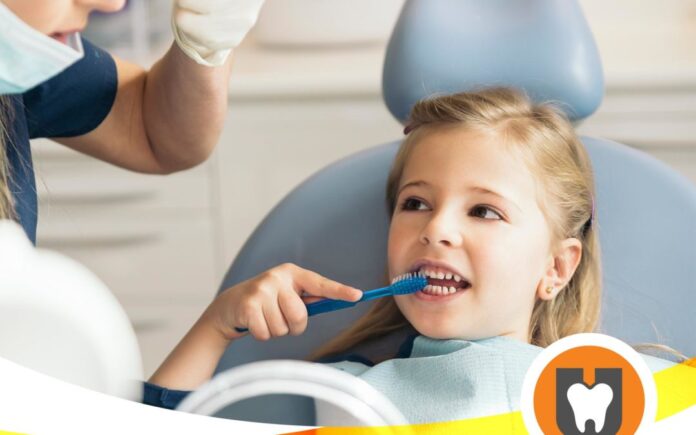As a parent, you want the best for your child, including their dental health. Regular dental care is crucial for maintaining good oral health and preventing future problems. In this post, we’ll discuss the eight essential dental treatments every child should receive and the age at which they should receive them.
Importance of Dental Care for Children
Your child’s first dental visit should be within six months of their first tooth eruption or by their first birthday. Regular dental care is essential for children, as their teeth and jaw are developing, and their oral health can impact their overall health and well-being. Dental problems can also lead to difficulties in speaking chewing and affecting their self-esteem.
So, without further ado, let’s discuss essential dental treatments for children.
Overview of the 8 Essential Dental Treatments
1. Dental Cleanings
Dental cleanings, also known as prophylaxis, are a routine part of preventive dental care. During a dental cleaning, a dentist or dental hygienist removes plaque, tartar, and any surface stains from your child’s teeth.
Regular dental cleanings help maintain good oral health by removing the buildup of plaque and tartar that can lead to tooth decay and gum disease. Dental cleanings also allow the dentist to identify any potential problems early and take appropriate action.
Your child’s first dental cleaning should be around the age of two or as soon as their first teeth start to come in. After that, it is recommended that children receive dental cleanings every six months.
2. Fluoride Treatments
Fluoride is a natural mineral that helps to prevent tooth decay and strengthen tooth enamel. Fluoride treatments are applied directly to the teeth in the form of a gel, foam, or varnish and help to strengthen the enamel and protect against tooth decay.
Fluoride treatment is one of the essential dental care services for children as it helps to strengthen their developing teeth and prevent tooth decay. Fluoride also helps to prevent cavities and promote oral health.
You can begin these treatments as soon as your child’s first teeth start to come in. After that, fluoride treatments should be part of every six-month dental check-up.
3. Dental X-rays
Dental X-rays are a diagnostic tool used to assess the health of your child’s teeth and jaw. X-rays provide a clear picture of what’s going on inside your child’s mouth and help the dentist identify potential problems early on.
Dental X-rays are essential for children because they help detect problems that cannot be seen with the naked eye, such as cavities between teeth, infections, and impacted teeth. X-rays also help the dentist monitor the development of your child’s jaw and teeth and make any necessary adjustments to ensure proper growth and alignment.
The frequency of dental X-rays for children depends on their individual needs and their dentist’s recommendation. However, it is typical for children to receive their first X-rays around the age of three or four, and then periodically as needed.
4. Sealants
Sealants are a thin, protective coating applied to the chewing surface of your child’s molars to prevent tooth decay. Sealants act as a barrier, protecting the teeth from plaque, tartar, and bacteria that can cause decay.
Sealants are a great preventive measure for children because they protect the chewing surfaces of the molars, which are the most susceptible to decay. They are also painless and non-invasive procedures that can be done quickly and easily.
It is recommended that children receive sealants as soon as their permanent molars come in, typically around the ages of six and twelve.
5. Space Maintainers
Space maintainers are devices that hold open the space created by a missing baby tooth to ensure that the permanent tooth has enough room to come in properly. Space maintainers can be removable or fixed and are customized to fit your child’s mouth according to this professional dentist in Raleigh.
Space maintainers are important for children because they help to ensure proper growth and alignment of permanent teeth. They also help prevent crowding and shifting of the other teeth, which can lead to problems.
The need for space maintainers will depend on your child’s individual circumstances, but they are typically recommended for children who have lost a baby tooth prematurely.
6. Orthodontic Treatments
Orthodontic treatments, such as braces or clear aligners, are used to correct bite and alignment issues in the teeth and jaw. Orthodontic treatments can be used to straighten crooked or crowded teeth, correct an overbite or underbite, and improve the overall health and appearance of your child’s smile.
Orthodontic treatments can help to improve your child’s oral health by correcting bite and alignment issues that can lead to problems like tooth decay and gum disease. They also boost your child’s self-esteem and confidence by giving them a straighter, healthier smile.
The best time for orthodontic treatments will depend on your child’s individual needs, but it is typically recommended that children have their first orthodontic evaluation around the age of seven.
7. Pulpotomies and Root Canal Treatments
Pulpotomies and root canal treatments are procedures used to treat infected or damaged teeth. During a pulpotomy, the dentist removes the infected portion of the pulp (the tooth’s innermost layer) and seals the remaining portion. A root canal treatment is necessary when the entire pulp of the tooth is infected and needs to be removed.
Pulpotomies and root canal treatments are crucial for children because they help to save infected or damaged teeth, prevent the spread of infection, and reduce the risk of future oral health problems. These procedures can also relieve pain and improve your child’s oral health and comfort.
The need for pulpotomies and root canal treatments will depend on your child’s individual needs, but they are typically recommended for children with infected or damaged teeth.
8. Fluoride Treatments
Fluoride treatments are applications of fluoride to the teeth to help strengthen and protect them from decay. Fluoride treatments can be in the form of a gel, foam, or varnish applied to the teeth or in the form of a supplement taken orally.
Fluoride treatments are important for children because they help to strengthen and protect the teeth, reducing the risk of decay and gum disease. They also help to remineralize teeth, reverse early stages of decay, and improve the overall health of your child’s smile.
The frequency of fluoride treatments for children will depend on their individual needs and the recommendation of their dentist, but they are typically recommended for children of all ages to help strengthen and protect their teeth.
Conclusion
These eight essential dental treatments for children are crucial for promoting and maintaining good oral health. By starting early and getting regular check-ups and treatments, you can help ensure that your child has a healthy smile. So, don’t hesitate to consult your child’s dentist and start taking advantage of these treatments today.
Read Also
- How to Find a 5-Star Dentist Near YouChoosing a dentist is more than just finding someone who can clean your teeth. It’s about selecting a trusted partner in your long-term oral health. A 5-star dentist not only provides excellent clinical care but also delivers a positive patient experience, from the moment you walk in until the moment you leave. Whether you’re new… Read more: How to Find a 5-Star Dentist Near You
- Your Easy-Peasy Guide to Brewing Amazing MatchaHey there! So, you’ve heard all the buzz about matcha – that vibrant green powder that’s not just pretty but packed with good stuff? It can seem a little fancy and intimidating at first, but trust me, making a delicious cup at home is simpler than you think. Forget complicated ceremonies for now; let’s just… Read more: Your Easy-Peasy Guide to Brewing Amazing Matcha
- Embracing Holistic Wellness: Insights from a Lansing, MI Health CenterReframing Health: Moving Beyond Symptom Management Treating only symptoms often offers quick relief, yet long-term results stay out of reach. When care zeroes in on isolated complaints, the bigger picture, such as stress, behavior, or lifestyle, often gets missed. Research shows that whole-person care, which looks at physical, emotional, and environmental factors, yields better outcomes… Read more: Embracing Holistic Wellness: Insights from a Lansing, MI Health Center
- VO₂ Max Testing Explained: What It Is & Why It Matters for Your HealthVO₂ max sounds like a term reserved for elite athletes, but it’s among the most accurate measures of your lifetime and general condition. Moreover, it goes beyond performance. Monitoring your VO₂ max will help you to ascertain your body’s capacity to control stress, its oxygen consumption efficiency, and your internal ageing process. If you have… Read more: VO₂ Max Testing Explained: What It Is & Why It Matters for Your Health
- So, what exactly is matcha?Think of matcha as green tea turned up to eleven! Instead of steeping leaves and tossing them out, matcha is made by grinding whole green tea leaves into this super-fine, vibrant green powder. You whisk it right into hot water (or milk!), meaning you’re drinking the entire leaf. That’s why folks say you get way… Read more: So, what exactly is matcha?






